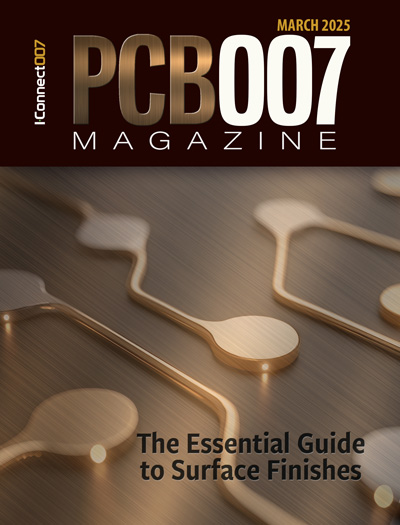-

-
News
News Highlights
- Books
Featured Books
- pcb007 Magazine
Latest Issues
Current Issue
In Pursuit of Perfection: Defect Reduction
For bare PCB board fabrication, defect reduction is a critical aspect of a company's bottom line profitability. In this issue, we examine how imaging, etching, and plating processes can provide information and insight into reducing defects and increasing yields.

Voices of the Industry
We take the pulse of the PCB industry by sharing insights from leading fabricators and suppliers in this month's issue. We've gathered their thoughts on the new U.S. administration, spending, the war in Ukraine, and their most pressing needs. It’s an eye-opening and enlightening look behind the curtain.

The Essential Guide to Surface Finishes
We go back to basics this month with a recount of a little history, and look forward to addressing the many challenges that high density, high frequency, adhesion, SI, and corrosion concerns for harsh environments bring to the fore. We compare and contrast surface finishes by type and application, take a hard look at the many iterations of gold plating, and address palladium as a surface finish.
- Articles
- Columns
Search Console
- Links
- Media kit
||| MENU - pcb007 Magazine
To Bake or Not to Bake: Examining the Impact of Waiving PCB Pre-Baking Prior to Assembly
November 15, 2016 | Yash Sutariya, Saturn Electronics/Saturn Flex SystemsEstimated reading time: 1 minute
I’ll always remember the summer of 2004 as the “Summer of Lead-Free.” Finally, Pb-free circuit boards were going into standard production mode. Assemblers focused the majority of their efforts (often at my behest) on final finish and proper laminate selection. What none of us saw coming, however, was the rash of delamination that would burn the entire industry during that long, hot lead-free summer.
After a good amount of research, Isola came up with a Lead-Free PCB Fabrication and Assembly Guideline that outlined various steps in the PCB fabrication and assembly processes that are critical to successful lead-free PCB assemblies. The most prominent process step that was added in this guideline is baking—during fabrication and, most critically, just prior to assembly. The goal of baking is simply to drive moisture out of the PCB.
Moisture plays a critical role in lead-free PCB assembly. Therefore, it is important to discern the specifications of your base laminate. One knee-jerk reaction of North American PCB users was to specify what they believed to be the highest end laminates, those that qualify under IPC 4101/126 and /129 slash sheets. These are typically phenolic-cured materials, which have much higher thermal properties in terms of glass transition temperature (Tg) and decomposition temperature (Td) that are required to survive lead-free assembly without via failure.
Unfortunately, other properties of the laminate and assembly temperatures create a perfect storm for reliability failures. These include: moisture absorption, interlaminate adhesion strength, and water vapor pressure at lead-free assembly temperatures.
Moisture Absorption
Moisture absorption of phenolic materials is more than 2x as compared to traditional FR-4 materials that qualify under IPC 4101/21. In the early days, the technical data sheets used a 0.028" thickness core material for moisture absorption measurement. Based on this test vehicle, phenolic laminates showed moisture absorption of 0.45%; comparatively standard FR-4 laminates scored a 0.20% rate of moisture absorption. Over time, I think someone got wise and changed the test vehicle to a 0.059" thickness core, thereby increasing the denominator of the weight loss calculation. This resulted in a moisture absorption rate of 0.20%, matching the rate of standard FR-4 laminate.
To read this entire article, which appeared in the November 2016 issue of SMT Magazine, click here.
Suggested Items
Top Investment Certification on 2nd Anniversary Boosts ESCATEC’s European Presence
06/09/2025 | ESCATECTwo significant milestones in recent days by ESCATEC’s business unit in Bulgaria adds much momentum to the EMS provider’s strategy to nearshore cost-effective and high-quality electronics assembly and plastic moulding services for its customers in the European Union.
Breaking Silos with Intelligence: Connectivity of Component-level Data Across the SMT Line
06/09/2025 | Dr. Eyal Weiss, CybordAs the complexity and demands of electronics manufacturing continue to rise, the smart factory is no longer a distant vision; it has become a necessity. While machine connectivity and line-level data integration have gained traction in recent years, one of the most overlooked opportunities lies in the component itself. Specifically, in the data captured just milliseconds before a component is placed onto the PCB, which often goes unexamined and is permanently lost once reflow begins.
Catching Up With AMI EMS President Greg Boyd: Our People Make the Difference
06/04/2025 | Dan BeaulieuI’ve had the privilege to work with countless companies in the electronics manufacturing space, but few have impressed me as deeply as Alternative Manufacturing Inc. (AMI). Based in Winthrop, Maine, AMI is a 100% employee-owned company that embodies the very best of what American manufacturing can be. AMI sets itself apart by its unwavering commitment to quality, transparency, and partnership.
IPC Releases Latest Standards and Revisions Updates
06/05/2025 | IPCEach quarter, IPC releases a list of standards that are new or have been updated. To view a complete list of newly published standards and standards revisions, translations, proposed standards for ballot, final drafts for industry review, working drafts, and project approvals, visit ipc.org/status. These are the latest releases for Q1 2025.
BEST Inc. Introduces StikNPeel Rework Stencil for Fast, Simple and Reliable Solder Paste Printing
06/02/2025 | BEST Inc.BEST Inc., a leader in electronic component rework services, training, and products is pleased to introduce StikNPeel™ rework stencils. This innovative product is designed for printing solder paste for placement of gull wing devices such as quad flat packs (QFPs) or bottom terminated components.


